Related Research Articles

Little Boy is the name of the type of atomic bomb used in the bombing of the Japanese city of Hiroshima on 6 August 1945 during World War II, making it the first nuclear weapon used in warfare. The bomb was dropped from the Boeing B-29 Superfortress Enola Gay piloted by Colonel Paul W. Tibbets Jr., commander of the 509th Composite Group, and Captain Robert A. Lewis. It exploded with an energy of approximately 15 kilotons of TNT (63 TJ) and had an explosion radius of approximately 1.3 kilometers which caused widespread death across the city. The Hiroshima bombing was the second nuclear explosion in history, after the Trinity nuclear test.

The Manhattan Project was a research and development program undertaken during World War II to produce the first nuclear weapons. It was led by the United States in collaboration with the United Kingdom and Canada. From 1942 to 1946, the project was directed by Major General Leslie Groves of the U.S. Army Corps of Engineers. Nuclear physicist J. Robert Oppenheimer was the director of the Los Alamos Laboratory that designed the bombs. The Army program was designated the Manhattan District, as its first headquarters were in Manhattan; the name gradually superseded the official codename, Development of Substitute Materials, for the entire project. The project absorbed its earlier British counterpart, Tube Alloys, and subsumed the program from the American civilian Office of Scientific Research and Development. The Manhattan Project employed nearly 130,000 people at its peak and cost nearly US$2 billion, over 80 percent of which was for building and operating the plants that produced the fissile material. Research and production took place at more than 30 sites across the US, the UK, and Canada.

The Boeing B-29 Superfortress is an American four-engined propeller-driven heavy bomber, designed by Boeing and flown primarily by the United States during World War II and the Korean War. Named in allusion to its predecessor, the B-17 Flying Fortress, the Superfortress was designed for high-altitude strategic bombing, but also excelled in low-altitude night incendiary bombing, and in dropping naval mines to blockade Japan. B-29s dropped the atomic bombs on Hiroshima and Nagasaki, the only aircraft ever to drop nuclear weapons in combat.

Bomb disposal is an explosives engineering profession using the process by which hazardous explosive devices are disabled or otherwise rendered safe. Bomb disposal is an all-encompassing term to describe the separate, but interrelated functions in the military fields of explosive ordnance disposal (EOD) and improvised explosive device disposal (IEDD), and the public safety roles of public safety bomb disposal (PSBD) and the bomb squad.

The GBU-43/B Massive Ordnance Air Blast is a large-yield bomb, developed for the United States military by Albert L. Weimorts, Jr. of the Air Force Research Laboratory. It was first tested in 2003. At the time of development, it was said to be the most powerful non-nuclear weapon in the American arsenal. The bomb is designed to be delivered by a C-130 Hercules, primarily the MC-130E Combat Talon I or MC-130H Combat Talon II variants. The bomb's name and nickname were inspired by Iraqi president Saddam Hussein's invocation of the "mother of all battles" during the 1991 Gulf War.
The Mark 84 or BLU-117 is a 2,000-pound (900 kg) American general purpose aircraft bomb. It is the largest of the Mark 80 series of weapons. Entering service during the Vietnam War, it became a commonly used US heavy unguided bomb. At the time, it was the third largest bomb by weight in the US inventory behind the 15,000-pound (6,800 kg) BLU-82 "Daisy Cutter" and the 3,000-pound (1,400 kg) M118 "demolition" bomb. It is currently sixth in size due to the addition of the 5,000 lb (2,300 kg) GBU-28 in 1991, the 22,600 lb (10,300 kg) GBU-43/B Massive Ordnance Air Blast bomb (MOAB) in 2003, and the 30,000 lb (14,000 kg) Massive Ordnance Penetrator.
The Mark 82 is a 500-pound (230 kg) unguided, low-drag general-purpose bomb, part of the United States Mark 80 series. The explosive filling is usually tritonal, though other compositions have sometimes been used.
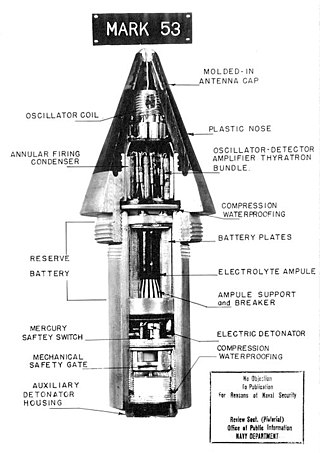
A proximity fuze is a fuze that detonates an explosive device automatically when it approaches within a certain distance of its target. Proximity fuzes are designed for elusive military targets such as airplanes and missiles, as well as ships at sea and ground forces. This sophisticated trigger mechanism may increase lethality by 5 to 10 times compared to the common contact fuze or timed fuze.
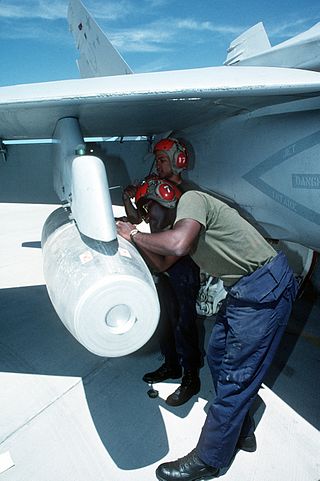
Incendiary weapons, incendiary devices, incendiary munitions, or incendiary bombs are weapons designed to start fires. They may destroy structures or sensitive equipment using fire, and sometimes operate as anti-personnel weaponry. Incendiaries utilize materials such as napalm, thermite, magnesium powder, chlorine trifluoride, or white phosphorus. Though colloquially often called "bombs", they are not explosives but in fact operate to slow the process of chemical reactions and use ignition rather than detonation to start or maintain the reaction. Napalm, for example, is petroleum especially thickened with certain chemicals into a gel to slow, but not stop, combustion, releasing energy over a longer time than an explosive device. In the case of napalm, the gel adheres to surfaces and resists suppression.

Unexploded ordnance and unexploded bombs (UXBs) are explosive weapons that did not explode when they were deployed and remain at detonative risk, sometimes many decades after they were used or discarded. When unwanted munitions are found, they are sometimes destroyed in controlled explosions, but accidental detonation of even very old explosives might also occur, sometimes with fatal consequences.

A blockbuster bomb or cookie was one of several of the largest conventional bombs used in World War II by the Royal Air Force (RAF). The term blockbuster was originally a name coined by the press and referred to a bomb which had enough explosive power to destroy an entire street or large building through the effects of blast in conjunction with incendiary bombs.
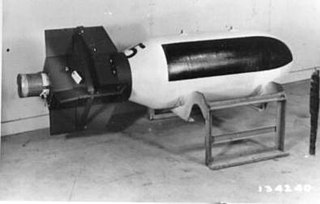
AZON, from "azimuth only", was one of the world's first guided weapons, deployed by the Allies and contemporary with the German Fritz X.

The ASM-N-2 Bat was a United States Navy World War II radar-guided glide bomb which was used in combat beginning in April 1945. It was developed and overseen by a unit within the National Bureau of Standards with assistance from the Navy's Bureau of Ordnance, the Massachusetts Institute of Technology, and Bell Telephone Laboratories. It is considered to be the first fully automated guided missile used in combat.

The United States Naval Surface Warfare Center Dahlgren Division (NSWCDD), named for Rear Admiral John A. Dahlgren, is located in King George County, Virginia, in close proximity to the largest fleet concentration area in the Navy. NSWCDD is part of the Naval Surface Warfare Centers under the Naval Sea Systems Command (NAVSEA). NSWCDD was initially established 16 October 1918 as a remote extension of Maryland's Indian Head Proving Ground used for testing naval guns. The Dahlgren site was named the Lower Station, Dahlgren Naval Proving Ground when it first opened. The location on the Potomac River was specifically chosen for the development of a long ballistic test range on the Potomac River, required for the testing of modern, high-powered munitions.

The United States Army Ordnance Corps, formerly the United States Army Ordnance Department, is a sustainment branch of the United States Army, headquartered at Fort Gregg-Adams, Virginia. The broad mission of the Ordnance Corps is to supply Army combat units with weapons and ammunition, including at times their procurement and maintenance. Along with the Quartermaster Corps and Transportation Corps, it forms a critical component of the U.S. Army logistics system.

Project Alberta, also known as Project A, was a section of the Manhattan Project which assisted in delivering the first nuclear weapons in the atomic bombing of Hiroshima and Nagasaki during World War II.

Wendover Air Force Base is a former United States Air Force base in Utah now known as Wendover Airport. During World War II, it was a training base for B-17 and B-24 bomber crews. It was the training site of the 509th Composite Group, the B-29 unit that carried out the atomic bombings of Hiroshima and Nagasaki.
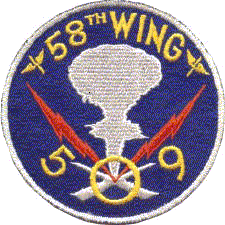
The 509th Composite Group was a unit of the United States Army Air Forces created during World War II and tasked with the operational deployment of nuclear weapons. It conducted the atomic bombings of Hiroshima and Nagasaki, Japan, in August 1945.

On 6 and 9 August 1945, the United States detonated two atomic bombs over the Japanese cities of Hiroshima and Nagasaki, respectively. The bombings killed between 150,000 and 246,000 people, most of whom were civilians, and remain the only use of nuclear weapons in an armed conflict. Japan surrendered to the Allies on 15 August, six days after the bombing of Nagasaki and the Soviet Union's declaration of war against Japan and invasion of Japanese-occupied Manchuria. The Japanese government signed the instrument of surrender on 2 September, effectively ending the war.
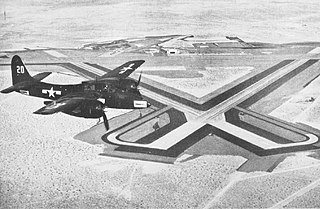
Project Camel encompassed the work performed by the California Institute of Technology (Caltech) in support of the Manhattan Project during World War II. These activities included the development of detonators and other equipment, testing of bomb shapes dropped from Boeing B-29 Superfortress bombers, and the Salt Wells Pilot Plant, where explosive components of nuclear weapons were manufactured.
References
- ↑ Bender, Bryan (July 30, 2012). "Bomb database useful for past, present wars". The Boston Globe. Archived from the original on July 31, 2012. Retrieved 7 August 2012.
- ↑ Dvorsky, George (August 2012). "The Pentagon has created a database of every bomb they've dropped since the First World War". io9 . Retrieved 7 August 2012.